service SKODA SUPERB 2010 2.G / (B6/3T) Owner's Guide
[x] Cancel search | Manufacturer: SKODA, Model Year: 2010, Model line: SUPERB, Model: SKODA SUPERB 2010 2.G / (B6/3T)Pages: 287, PDF Size: 16.59 MB
Page 210 of 287
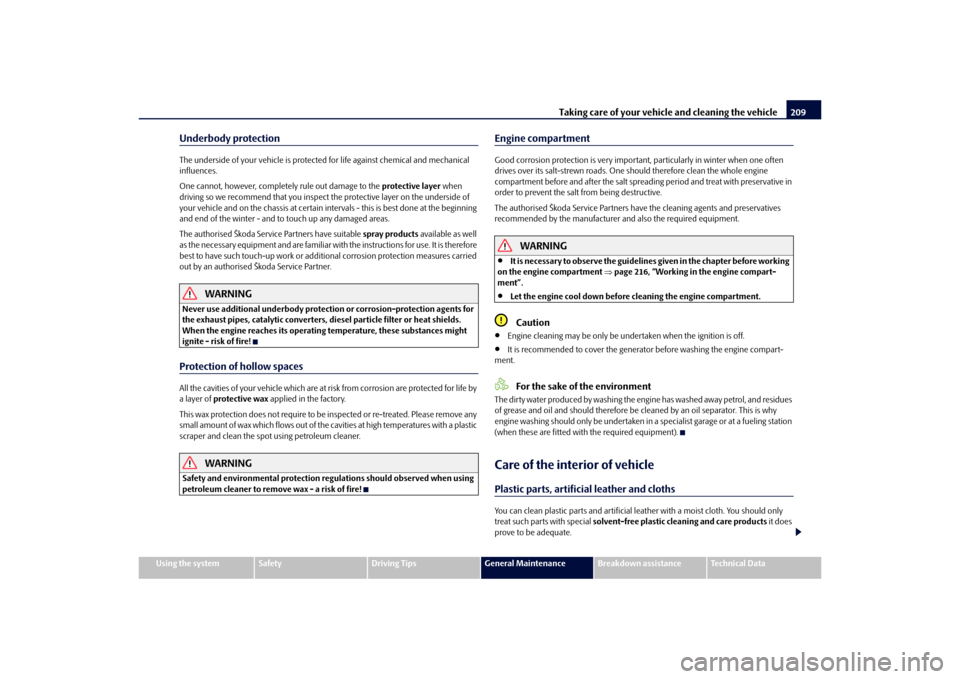
Taking care of your vehicle and cleaning the vehicle209
Using the system
Safety
Driving Tips
General Maintenance
Breakdown assistance
Technical Data
Underbody protectionThe underside of your vehicle is protected for life against chemical and mechanical
influences.
One cannot, however, completely rule out damage to the protective layer when
driving so we recommend that you inspect the protective layer on the underside of
your vehicle and on the chassis at certain intervals - this is best done at the beginning
and end of the winter - and to touch up any damaged areas.
The authorised Škoda Service Partners have suitable spray products available as well
as the necessary equipment and are familiar with the instructions for use. It is therefore
best to have such touch-up work or additional corrosion protection measures carried
out by an authorised Škoda Service Partner.
WARNING
Never use additional underbody protection or corrosion-protection agents for
the exhaust pipes, catalytic converters, di esel particle filter or heat shields.
When the engine reaches its operating temperature, these substances might
ignite - risk of fire!Protection of hollow spacesAll the cavities of your vehicle which are at risk from corrosion are protected for life by
a layer of protective wax applied in the factory.
This wax protection does not require to be inspected or re-treated. Please remove any
small amount of wax which flows out of the cavities at high temperatures with a plastic
scraper and clean the spot using petroleum cleaner.
WARNING
Safety and environmental pr otection regulations should observed when using
petroleum cleaner to remove wax - a risk of fire!
Engine compartmentGood corrosion protection is very importan t, particularly in winter when one often
drives over its salt-strewn roads. One should therefore clean the whole engine
compartment before and after the salt spreading period and treat with preservative in
order to prevent the salt from being destructive.
The authorised Škoda Service Partners have the cleaning agents and preservatives
recommended by the manufacturer and also the required equipment.
WARNING
It is necessary to observ e the guidelines given in the chapter before working
on the engine compartment page 216, “Working in the engine compart-
ment”.
Let the engine cool down before cleaning the engine compartment.Caution
Engine cleaning may be only be un dertaken when the ignition is off.
It is recommended to cover the generator before washing the engine compart-
ment.For the sake of the environment
The dirty water produced by washing the engine has washed away petrol, and residues
of grease and oil and should therefore be cleaned by an oil separator. This is why
engine washing should only be undertaken in a specialist garage or at a fueling station
(when these are fitted with the required equipment).Care of the interior of vehiclePlastic parts, artificial leather and clothsYou can clean plastic parts and artificial leather with a moist cloth. You should only
treat such parts with special solvent-free plastic cleaning and care products it does
prove to be adequate.
s3fg.2.book Page 209 Friday, April 30, 2010 12:17 PM
Page 211 of 287
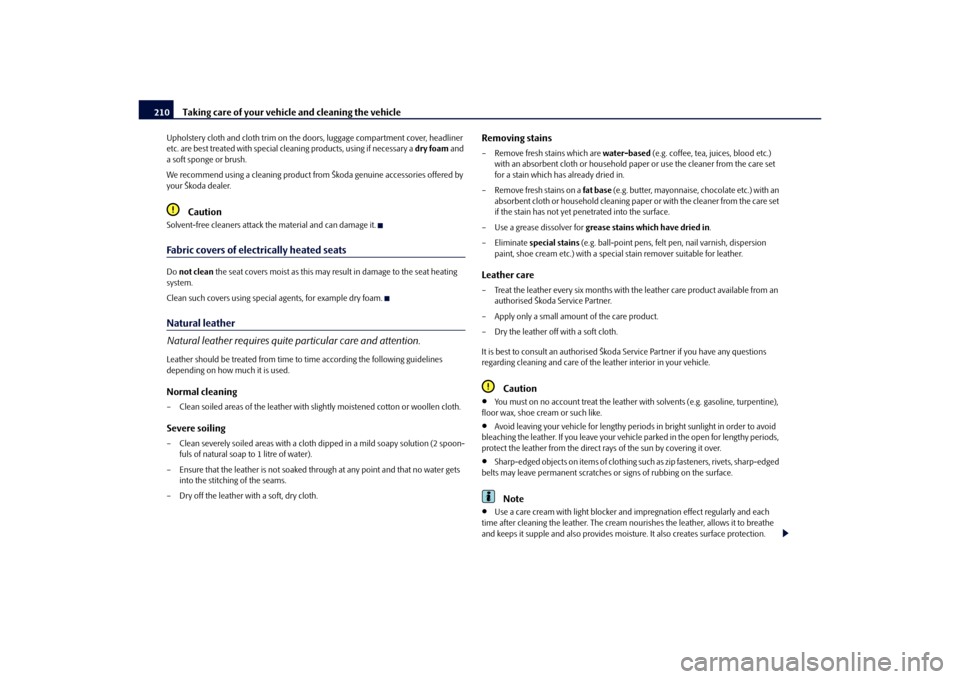
Taking care of your vehicle and cleaning the vehicle
210
Upholstery cloth and cloth trim on the d oors, luggage compartment cover, headliner
etc. are best treated with special cleaning products, using if necessary a dry foam and
a soft sponge or brush.
We recommend using a cleaning product from Škoda genuine accessories offered by
your Škoda dealer.
Caution
Solvent-free cleaners attack th e material and can damage it.Fabric covers of electrically heated seatsDo not clean the seat covers moist as this may re sult in damage to the seat heating
system.
Clean such covers using specia l agents, for example dry foam.Natural leather
Natural leather requires quite particular care and attention.Leather should be treated from time to time according the following guidelines
depending on how much it is used.Normal cleaning– Clean soiled areas of the leather with slightly moistened cotton or woollen cloth.Severe soiling– Clean severely soiled areas with a cloth dipped in a mild soapy solution (2 spoon-
fuls of natural soap to 1 litre of water).
– Ensure that the leather is not soaked through at any point and that no water gets into the stitching of the seams.
– Dry off the leather with a soft, dry cloth.
Removing stains– Remove fresh stains which are water-based (e.g. coffee, tea, juices, blood etc.)
with an absorbent cloth or household paper or use the cleaner from the care set
for a stain which has already dried in.
– Remove fresh stains on a fat base (e.g. butter, mayonnaise, chocolate etc.) with an
absorbent cloth or household cleaning paper or with the cleaner from the care set
if the stain has not yet pe netrated into the surface.
– Use a grease dissolver for grease stains which have dried in .
–Eliminate special stains (e.g. ball-point pens, felt pe n, nail varnish, dispersion
paint, shoe cream etc.) with a special stain remover suitable for leather.Leather care– Treat the leather every six months with th e leather care product available from an
authorised Škoda Service Partner.
– Apply only a small amount of the care product.
– Dry the leather off with a soft cloth.
It is best to consult an authorised Škod a Service Partner if you have any questions
regarding cleaning and care of the leather interior in your vehicle.
Caution
You must on no account treat the leather wi th solvents (e.g. gasoline, turpentine),
floor wax, shoe cream or such like.
Avoid leaving your vehicle for lengthy period s in bright sunlight in order to avoid
bleaching the leather. If you leave your vehicle parked in the open for lengthy periods,
protect the leather from the direct ra ys of the sun by covering it over.
Sharp-edged objects on items of clothing su ch as zip fasteners, rivets, sharp-edged
belts may leave permanent scratches or signs of rubbing on the surface.Note
Use a care cream with ligh t blocker and impregnation effect regularly and each
time after cleaning the leathe r. The cream nourishes the leather, allows it to breathe
and keeps it supple and also provides mois ture. It also creates surface protection.
s3fg.2.book Page 210 Friday, April 30, 2010 12:17 PM
Page 212 of 287

Taking care of your vehicle and cleaning the vehicle211
Using the system
Safety
Driving Tips
General Maintenance
Breakdown assistance
Technical Data
Clean the leather every 2 to 3 months, remove fresh soiling each time this occurs.
Remove fresh stains such as those from ball-point pens, ink, lipstick, shoe cream
etc., as quickly as possible.
Care also for the leather dye. Refreshen ar eas which have lost their colour with a
special coloured leather cream as required.
The leather is a natural material with specific properties. During the use of the
vehicle, minor optical changes can occur on the leather parts of the covers (e. g wrin-
kles or creases as a result of the stress of the covers).
Seat belts– Keep the seat belts clean!
– Wash seat belts which have become soiled using a mild soapy solution.
– Inspect the seat belts regularly to ensure they are in good condition.
Belt webbing which has become severely so iled may prevent the inertia reel from
reeling up the belt properly.
WARNING
The seat belts must not be removed for cleaning.
Never clean the seat belts chemically as dry cleaning may destroy the fabric.
The seat belts must also not be allowed to come into contact with corrosive
liquids (such as acids etc.).
Seat belts which have damage to the webbing, the connections, the inertia
reel or the lock should be replaced by an authorised Škoda Service Partner.
Inertia reel belts must be completely dried before being reeled up.
s3fg.2.book Page 211 Friday, April 30, 2010 12:17 PM
Page 214 of 287
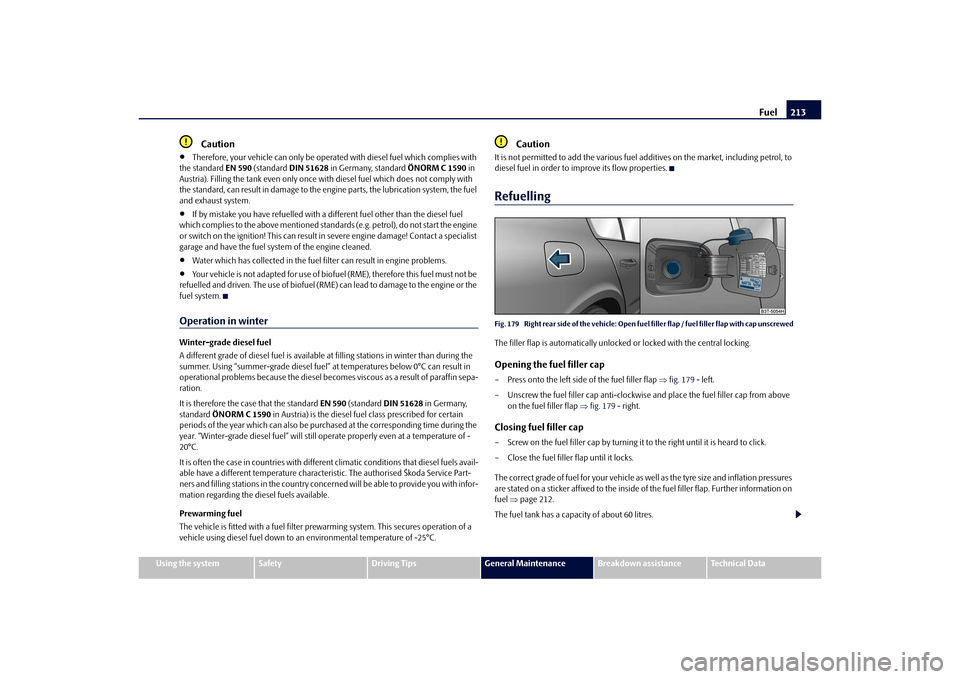
Fuel213
Using the system
Safety
Driving Tips
General Maintenance
Breakdown assistance
Technical Data
Caution
Therefore, your vehicle can only be operated with diesel fuel which complies with
the standard EN 590 (standard DIN 51628 in Germany, standard ÖNORM C 1590 in
Austria). Filling the tank even only once wi th diesel fuel which does not comply with
the standard, can result in damage to the engine parts, the lubrication system, the fuel
and exhaust system.
If by mistake you have refuelled with a different fuel other than the diesel fuel
which complies to the above mentioned standards (e.g. petrol), do not start the engine
or switch on the ignition! This can result in severe engine damage! Contact a specialist
garage and have the fuel sy stem of the engine cleaned.
Water which has collected in the fuel fi lter can result in engine problems.
Your vehicle is not adapted for use of biofue l (RME), therefore this fuel must not be
refuelled and driven. The use of biofuel (RME) can lead to damage to the engine or the
fuel system.
Operation in winterWinter-grade diesel fuel
A different grade of diesel fuel is available at filling stations in winter than during the
summer. Using “summer-grade diesel fuel” at temperatures below 0°C can result in
operational problems because th e diesel becomes viscous as a result of paraffin sepa-
ration.
It is therefore the case that the standard EN 590 (standard DIN 51628 in Germany,
standard ÖNORM C 1590 in Austria) is the diesel fuel class prescribed for certain
periods of the year which can also be purc hased at the corresponding time during the
year. “Winter-grade diesel fuel” will still operate properly even at a temperature of -
20°C.
It is often the case in countries with different climatic conditions that diesel fuels avail-
able have a different temperature characteristic. The authorised Škoda Service Part-
ners and filling stations in the country concer ned will be able to provide you with infor-
mation regarding the diesel fuels available.
Prewarming fuel
The vehicle is fitted with a fuel filter prewarming system. This secures operation of a
vehicle using diesel fuel down to an environmental temperature of -25°C.
Caution
It is not permitted to add the various fuel additives on the market, including petrol, to
diesel fuel in order to improve its flow properties.RefuellingFig. 179 Right rear side of the ve hicle: Open fuel filler flap / fuel filler flap with cap unscrewedThe filler flap is automatically unlocked or locked with the central locking.Opening the fuel filler cap– Press onto the left side of the fuel filler flap fig. 179 - left.
– Unscrew the fuel filler ca p anti-clockwise and place the fuel filler cap from above
on the fuel filler flap fig. 179 - right.Closing fuel filler cap– Screw on the fuel filler cap by turning it to the right until it is heard to click.
– Close the fuel filler flap until it locks.
The correct grade of fuel for your vehicle as well as the tyre size and inflation pressures
are stated on a sticker affixed to the inside of the fuel filler flap. Further information on
fuel page 212.
The fuel tank has a capacity of about 60 litres.
s3fg.2.book Page 213 Friday, April 30, 2010 12:17 PM
Page 219 of 287
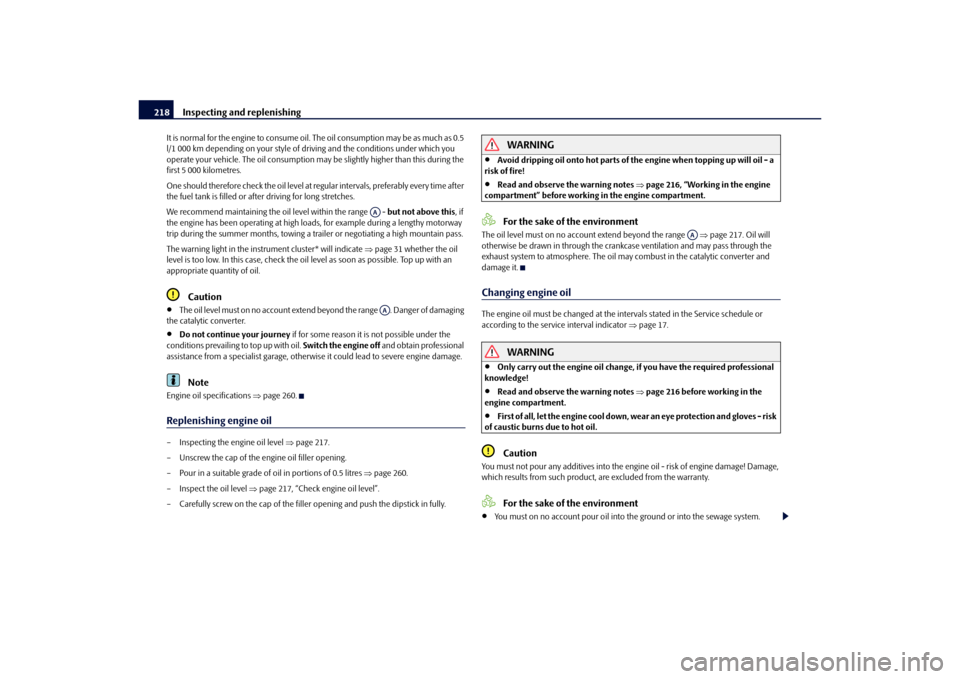
Inspecting and replenishing
218
It is normal for the engine to consume oil. The oil consumption may be as much as 0.5
l/1 000 km depending on your style of driving and the conditions under which you
operate your vehicle. The oil consumption may be slightly hi gher than this during the
first 5 000 kilometres.
One should therefore check the oil level at regular intervals, preferably every time after
the fuel tank is filled or after driving for long stretches.
We recommend maintaining the oil level within the range - but not above this, if
the engine has been operating at high load s, for example during a lengthy motorway
trip during the summer months, towing a tr ailer or negotiating a high mountain pass.
The warning light in the instrument cluster* will indicate page 31 whether the oil
level is too low. In this case, check the oil level as soon as possible. Top up with an
appropriate quantity of oil.
Caution
The oil level must on no account extend beyond the range . Danger of damaging
the catalytic converter.
Do not continue your journey if for some reason it is not possible under the
conditions prevailing to top up with oil. Switch the engine off and obtain professional
assistance from a specialist garage, otherwise it could lead to severe engine damage.Note
Engine oil specifications page 260.Replenishing engine oil– Inspecting the engine oil level page 217.
– Unscrew the cap of the engine oil filler opening.
– Pour in a suitable grade of oil in portions of 0.5 litres page 260.
– Inspect the oil level page 217, “Check engine oil level”.
– Carefully screw on the cap of the filler opening and push the dipstick in fully.
WARNING
Avoid dripping oil onto hot parts of the engine when topping up will oil - a
risk of fire!
Read and observe the warning notes page 216, “Working in the engine
compartment” before working in the engine compartment.For the sake of the environment
The oil level must on no acco unt extend beyond the range page 217. Oil will
otherwise be drawn in through the crankc ase ventilation and may pass through the
exhaust system to atmosphere. The oil ma y combust in the catalytic converter and
damage it.Changing engine oilThe engine oil must be changed at the intervals stated in the Service schedule or
according to the service interval indicator page 17.
WARNING
Only carry out the engine oil change, if you have the required professional
knowledge!
Read and observe the warning notes page 216 before working in the
engine compartment.
First of all, let the engine cool down, we ar an eye protection and gloves - risk
of caustic burns due to hot oil.Caution
You must not pour any additives into the engine oil - risk of engine damage! Damage,
which results from such product, are excluded from the warranty.
For the sake of the environment
You must on no account pour oil into the ground or into the sewage system.
AAAA
AA
s3fg.2.book Page 218 Friday, April 30, 2010 12:17 PM
Page 220 of 287
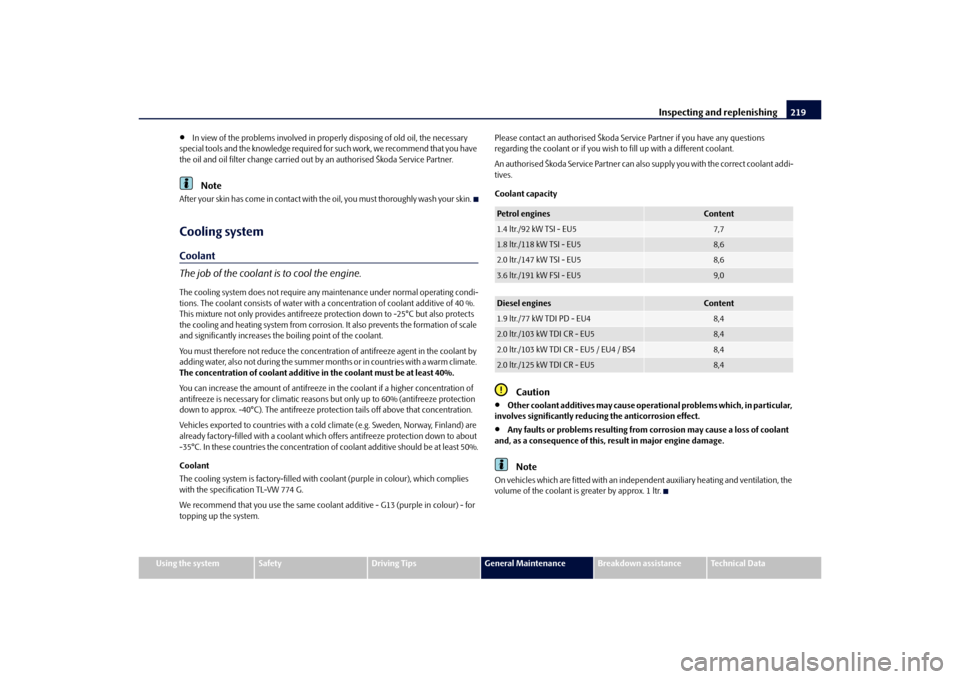
Inspecting and replenishing219
Using the system
Safety
Driving Tips
General Maintenance
Breakdown assistance
Technical Data
In view of the problems involved in prop erly disposing of old oil, the necessary
special tools and the knowledge required for such work, we recommend that you have
the oil and oil filter change carried out by an authorised Škoda Service Partner.Note
After your skin has come in contact with th e oil, you must thoroughly wash your skin.Cooling systemCoolant
The job of the coolant is to cool the engine.The cooling system does not require any maintenance under normal operating condi-
tions. The coolant consists of water with a concentration of coolant additive of 40 %.
This mixture not only provides antifreeze protection down to -25°C but also protects
the cooling and heating system from corrosion. It also prevents the formation of scale
and significantly increases the boiling point of the coolant.
You must therefore not reduce the concentration of antifreeze agent in the coolant by
adding water, also not during the summer mo nths or in countries with a warm climate.
The concentration of coolant additive in the coolant must be at least 40%.
You can increase the amount of antifreeze in the coolant if a higher concentration of
antifreeze is necessary for climatic reasons but only up to 60% (antifreeze protection
down to approx. -40°C). The antifreeze prot ection tails off above that concentration.
Vehicles exported to countries with a cold climate (e.g. Sweden, Norway, Finland) are
already factory-filled with a coolant which offers antifreeze protection down to about
-35°C. In these countries the concentration of coolant additive should be at least 50%.
Coolant
The cooling system is factor y-filled with coolant (purple in colour), which complies
with the specification TL-VW 774 G.
We recommend that you use the same coolan t additive - G13 (purple in colour) - for
topping up the system. Please contact an authorised Škoda Serv
ice Partner if you have any questions
regarding the coolant or if you wish to fill up with a different coolant.
An authorised Škoda Service Partner can also supply you with the correct coolant addi-
tives.
Coolant capacity
Caution
Other coolant additives may cause operational problems which, in particular,
involves significantly reduci ng the anticorrosion effect.
Any faults or problems resulting from corrosion may cause a loss of coolant
and, as a consequenc e of this, result in major engine damage.Note
On vehicles which are fitted with an indepe ndent auxiliary heating and ventilation, the
volume of the coolant is greater by approx. 1 ltr.Petrol engines
Content
1.4 ltr./92 kW TSI - EU5
7,7
1.8 ltr./118 kW TSI - EU5
8,6
2.0 ltr./147 kW TSI - EU5
8,6
3.6 ltr./191 kW FSI - EU5
9,0
Diesel engines
Content
1.9 ltr./77 kW TDI PD - EU4
8,4
2.0 ltr./103 kW TDI CR - EU5
8,4
2.0 ltr./103 kW TDI CR - EU5 / EU4 / BS4
8,4
2.0 ltr./125 kW TDI CR - EU5
8,4
s3fg.2.book Page 219 Friday, April 30, 2010 12:17 PM
Page 223 of 287
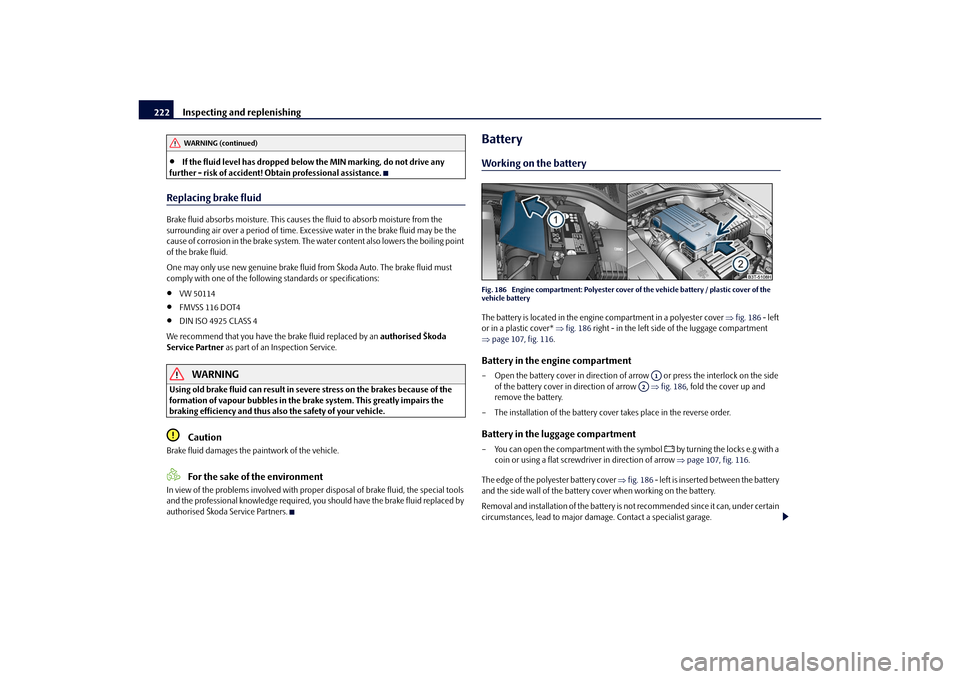
Inspecting and replenishing
222
If the fluid level has dropped below the MIN marking, do not drive any
further - risk of accident! Obtain professional assistance.
Replacing brake fluidBrake fluid absorbs moisture. This causes the fluid to absorb moisture from the
surrounding air over a period of time. Excessive water in the brake fluid may be the
cause of corrosion in the brake system. The water content also lowers the boiling point
of the brake fluid.
One may only use new genuine brake fluid from Škoda Auto. The brake fluid must
comply with one of the following standards or specifications:
VW 50114
FMVSS 116 DOT4
DIN ISO 4925 CLASS 4
We recommend that you have the brake fluid replaced by an authorised Škoda
Service Partner as part of an Inspection Service.
WARNING
Using old brake fluid can result in severe stress on the brakes because of the
formation of vapour bubbles in the br ake system. This greatly impairs the
braking efficiency and thus also the safety of your vehicle.
Caution
Brake fluid damages the paintwork of the vehicle.
For the sake of the environment
In view of the problems involved with proper disposal of brake fluid, the special tools
and the professional knowledge required, you should have the brake fluid replaced by
authorised Škoda Service Partners.
BatteryWorking on the batteryFig. 186 Engine compartment: Polyester cover of the vehicle battery / plastic cover of the
vehicle batteryThe battery is located in the engine compartment in a polyester cover fig. 186 - left
or in a plastic cover* fig. 186 right - in the left side of the luggage compartment
page 107, fig. 116.Battery in the engine compartment– Open the battery cover in direction of arrow or press the interlock on the side
of the battery cover in direction of arrow fig. 186 , fold the cover up and
remove the battery.
– The installation of the battery co ver takes place in the reverse order.Battery in the luggage compartment– You can open the compartment with the symbol
by turning the locks e.g with a
coin or using a flat screwdriver in direction of arrow page 107, fig. 116 .
The edge of the polyester battery cover fig. 186 - left is inserted between the battery
and the side wall of the battery cover when working on the battery.
Removal and installation of the battery is not recommended since it can, under certain
circumstances, lead to major dama ge. Contact a specialist garage.
WARNING (continued)
A1
A2
s3fg.2.book Page 222 Friday, April 30, 2010 12:17 PM
Page 226 of 287

Inspecting and replenishing225
Using the system
Safety
Driving Tips
General Maintenance
Breakdown assistance
Technical Data
Replacement batteries with three-tone indi cator, which were obtained from Škoda
original accessories, are marked with the code 000 915 105 Ax, whereby “x” stands for
a variable. The exact marking can be e.g. 000 915 105 AB.
Inspecting the electrolyte levelThe battery is practically maintenance-free under normal operating conditions. We
do, however, recommend that you have the electrolyte level inspected from time to
time by a specialist garage when outside temperatures are high or when driving on
long trips. You should also have the electrolyte level page 225 checked each time
the battery is charged.
The electrolyte level of the battery will al so be checked as part of the Inspection
Service.Operation in winterThe battery has to provide greater amounts of electricity during the winter. It also has
only part of the initial power output at low temperatures that it has at normal temper-
atures.
A discharged battery may already freez e at temperatures just below 0°C.
We therefore recommend that you have the battery checked by an authorised Škoda
Service Partner before the start of the winter and recharged if necessary.
WARNING
Never charge a frozen or thawed battery - risk of explosion and caustic burns.
Replace a frozen battery.Charging the battery
A properly charged battery is essentia l for reliably starting the engine.– Read the warning notes in “Working on the battery” on page 222 and .
– Switch the ignition and all electrical components off. – Only for “quick-charging”: Disconnect both
battery cables (first of all “negative”,
then “positive”).
– Carefully attach the terminal clamps of the charger to the battery terminals (red =
“positive”, black = “negative”).
– You can now plug the mains cable of the charger into the power socket and switch
on the charger.
– When charging is completed: switch th e charger off and unplug the mains cable
from the power socket.
– Only then should you disconnect th e terminal clamps of the charger.
– Reconnect the cables to the battery (first of all “positive”, then “negative”).
It is not normally necessary to disconnect the cables of the battery if you recharge the
battery using low amperages (as for example from a mini-charger). Please also refer
to the instructions from the charger manufacturer.
A charging current of 0.1 of the total battery capacity (or lower) is that which should be
used until full charging is achieved.
It is, however, necessary to disconnect both cables before charging the battery with
high amperages, so-called “ quick-charging”.
“Quick-charging” a battery is dangerous in “Working on the battery” on
page 222. It requires a special charger an d appropriate knowledge. We therefore
recommend that you have your battery quic k-charged only by an authorised Škoda
Service Partner.
A discharged battery may already freeze at temperatures just below 0°C . We
recommend that you no longer use a battery which has thawed out because the casing
of the battery may be cracked through the formation of ice and this would allow
battery electrolyte to flow out.
The vent plugs of the battery should not be opened for charging.
WARNING
Never charge a frozen or thawed battery - risk of explosion and caustic burns.
Replace a frozen battery.
Never charge a battery which has a too lo w electrolyte level - risk of explo-
sion and caustic burns.
s3fg.2.book Page 225 Friday, April 30, 2010 12:17 PM
Page 227 of 287
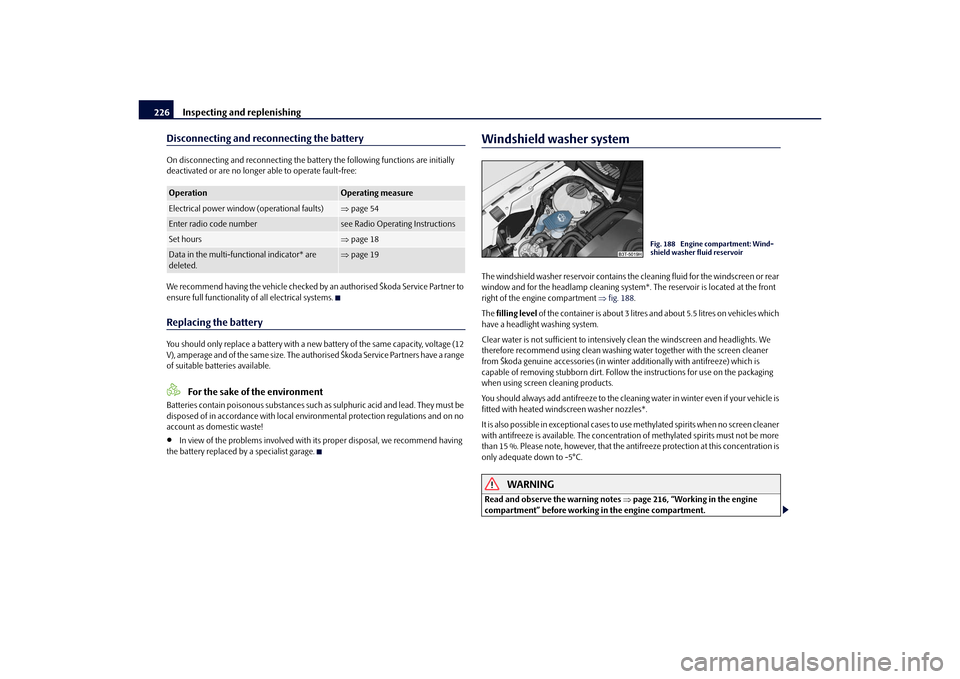
Inspecting and replenishing
226
Disconnecting and reconnecting the batteryOn disconnecting and reconnecting the batt ery the following functions are initially
deactivated or are no longer able to operate fault-free:
We recommend having the vehi cle checked by an authorised Škoda Service Partner to
ensure full functionality of all electrical systems.Replacing the batteryYou should only replace a battery with a ne w battery of the same capacity, voltage (12
V), amperage and of the same size. The auth orised Škoda Service Partners have a range
of suitable batteries available.
For the sake of the environment
Batteries contain poisonous substances such as sulphuric acid and lead. They must be
disposed of in accordance with local environmental protection regulations and on no
account as domestic waste!
In view of the problems involved with it s proper disposal, we recommend having
the battery replaced by a specialist garage.
Windshield washer systemThe windshield washer reservoir contains the cleaning fluid for the windscreen or rear
window and for the headlamp cleaning system *. The reservoir is located at the front
right of the engine compartment fig. 188 .
The filling level of the container is about 3 litres and about 5.5 litres on vehicles which
have a headlight washing system.
Clear water is not sufficient to intensively clean the windscreen and headlights. We
therefore recommend using clean washing water together with the screen cleaner
from Škoda genuine accessories (in winter additionally with antifreeze) which is
capable of removing stubborn dirt. Follow the instructions for use on the packaging
when using screen cleaning products.
You should always add antifreeze to the cleaning water in winter even if your vehicle is
fitted with heated wind screen washer nozzles*.
It is also possible in exceptional cases to use methylated spirits when no screen cleaner
with antifreeze is available. The concentration of methylated spirits must not be more
than 15 %. Please note, however, that the anti freeze protection at this concentration is
only adequate down to -5°C.
WARNING
Read and observe the warning notes page 216, “Working in the engine
compartment” before working in the engine compartment.
Operation
Operating measure
Electrical power window (operational faults)
page 54
Enter radio code number
see Radio Operat ing Instructions
Set hours
page 18
Data in the multi-functional indicator* are
deleted.
page 19
Fig. 188 Engine compartment: Wind-
shield washer fluid reservoir
s3fg.2.book Page 226 Friday, April 30, 2010 12:17 PM
Page 228 of 287

Inspecting and replenishing227
Using the system
Safety
Driving Tips
General Maintenance
Breakdown assistance
Technical Data
Caution
On no account should you add radiator an tifreeze or other additives to the wind-
screen washer fluid.
If the vehicle is fitted with a headligh t cleaning system, you should only add
cleaning products which do no t attack the polycarbonate coating of the headlights to
the windscreen washer fluid. Please contact an authorised Škoda Service Partner, who
will tell you which clea ning agent you can use.
s3fg.2.book Page 227 Friday, April 30, 2010 12:17 PM